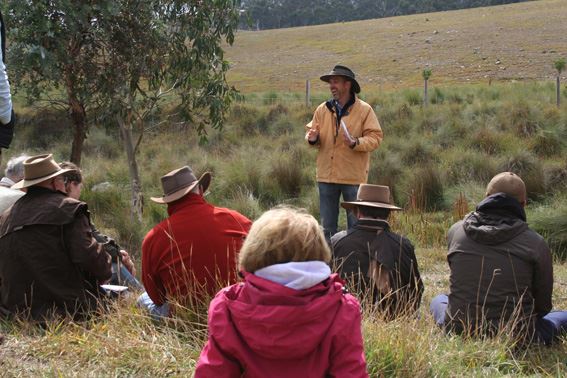Dr Dean Revell from Revell Science in Western Australia was the keynote speaker at the Fodder Trees and Shrubs for Grazing Systems field day in Bywong. Over 35 farmers attended to learn about how native fodder trees and shrubs can be incorporated into livestock systems.
Dr Revell led a discussion about how fodder grazing systems using native shrubs combined with pasture can provide stock on small and large farms with feed during autumn and winter feed gaps (or any other time when the weather is being unkind). We learned that shrubs use ground water not accessible to grasses, bring nutrients to the surface for other plants to use and provide shade and shelter for grazing stock. Dr Revell also outlined the amazing ways in which stock learn to use fodder shrubs and how we can use animal behaviour to teach stock to eat new plants.

Grazing systems using shrubs also benefit animals by reducing stress caused by extremes in temperature, allowing the metabolic system of the animal to work efficiently which keeps growth rates steady. Some shrub species also provide medicinal value to the livestock thereby reducing worm burdens and potentially methane gas production. Farm productivity improves by reducing the cost of inputs including supplementary feed and drenches. It also allows farmers flexibility in rotating paddocks and feed resources. The downside to fodder crops is the initial start-up cost, but economic modelling over the long term showed improved grazing productivity.
Geoff Butler from Wamboin Gearys Gap Landcare was on hand to share his extensive knowledge on local plant species that could be suitable for fodder. He discussed the establishment of shelter belts and the importance of site preparation including ripping, time of planting and tube stock establishment. Establishing effective windbreaks can have many positive effects in farming systems in addition to slowing wind speeds at ground level including providing habitat for beneficial birds and insects, providing additional feed resources during drought (using fodder trees suitable for coppicing) and providing shade and shelter for stock.
South East Local Landcare Services Officer Matthew Lieschke gave a seasonal update and demonstrated how to calculate supplementary feeding rates for livestock if you do not have any fodder shrubs to fill the gap.
A key message from the field day is that incorporating native fodder shrubs into a grazing system can reduce the need to hand feed and that while stock are using the fodder shrub area, other pastures are able to recover better.
Resources
The Enrich Project that Dr Revell worked on has now finished but the reports from the project are available online:
Perennial Fodder Shrubs – Key Findings from Enrich
Perennial Forage Shrubs – From Principles to Practice on Australian Farms
More information about the work of Dr Revell including a free worksheet for shrub forage calculations: www.revellscience.com.au
Follow up book published by Mallee CMA: Native Forage Shrubs for Low-Rainfall Areas
Local Land Services Seasonal Updates and Newsletters from southeast.lls.nsw.gov.au
A list of native plants suitable for growing on small farms in the Capital Region is provided in the back section of the locally written book Look After Your Natural Assets.
The field day was made possible with funding and support from South East Local Land Services.